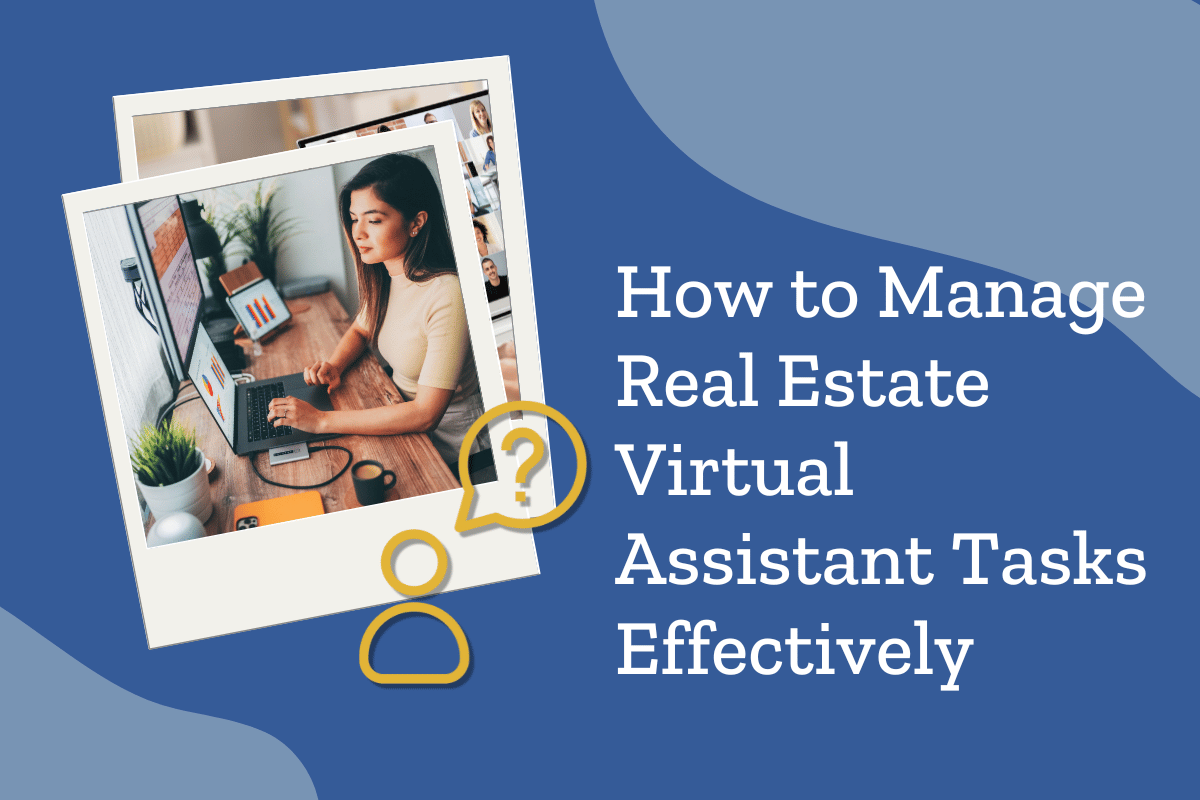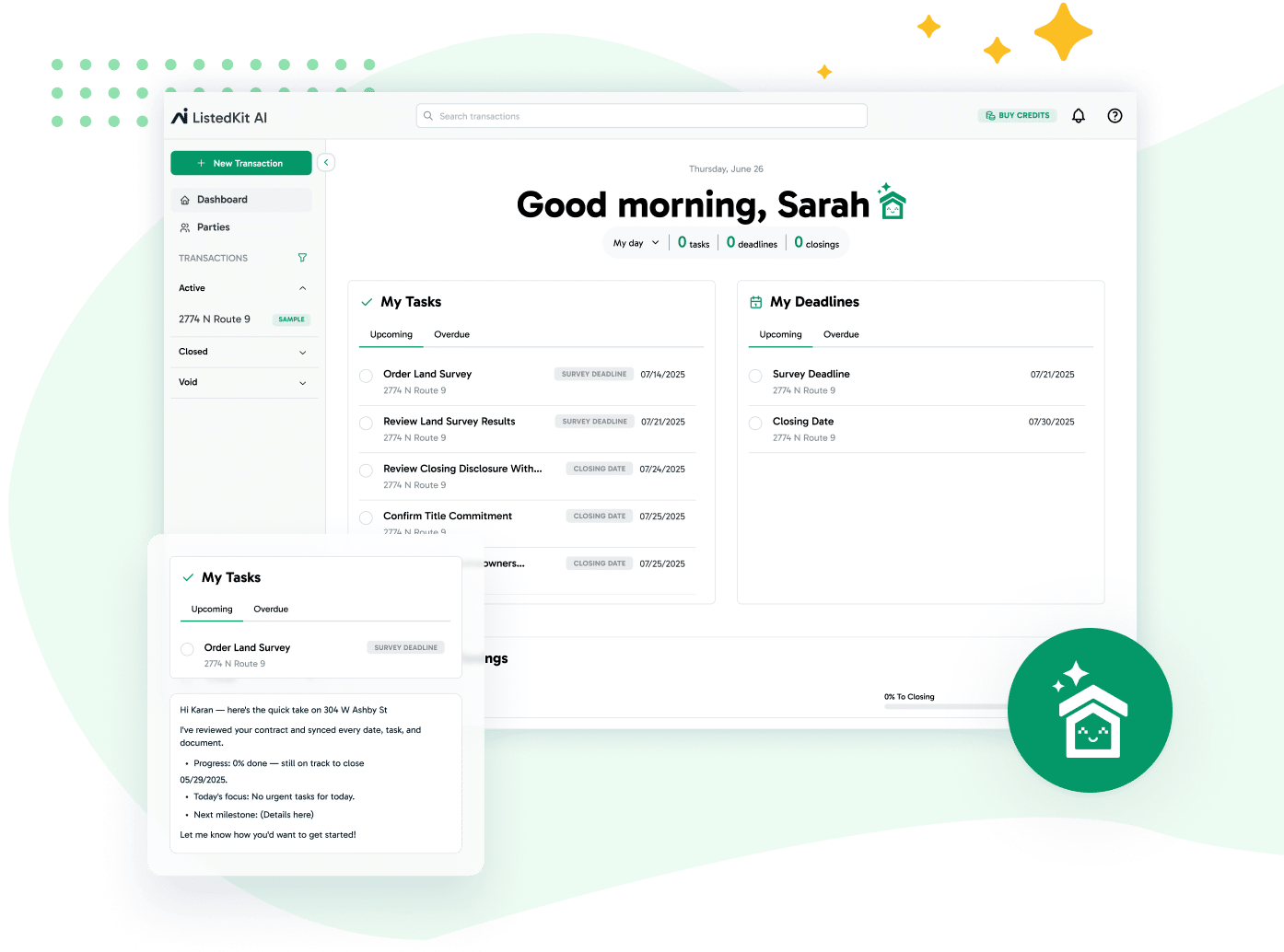As a transaction coordinator (TC), you are working with agents to help coordinate seamless transitions from contract to close. But what if your success becomes your biggest challenge? When your business outgrows your solo capacity, it’s time to evolve.
We recently hosted an eye-opening webinar with Tanya Knowles, a TC who revolutionized her business by scaling to manage over 140 monthly transactions with a team of virtual assistants (VAs). Inspired by Tanya’s success, we’ve distilled key insights into this comprehensive guide.
Whether you’re drowning in paperwork or turning away clients, this roadmap will navigate you through the transition from solo operator to VA team manager. Learn how to leverage real estate virtual assistant tasks to scale your TC business strategically, maintaining quality while reclaiming your work-life balance. Ready to unlock your business’s true potential? Let’s dive in.
Why Consider Hiring Virtual Assistants?
Before diving into the “how,” let’s address the “why.” Many TCs hesitate to bring on help, fearing loss of control or quality. However, there are compelling reasons to delegate real estate virtual assistant tasks and free up your time for high-value activities:
- Increased Capacity: With VAs handling routine tasks, you can take on more clients and transactions.
- Better Work-Life Balance: Delegate tasks to avoid working late nights and weekends.
- Focus on High-Value Activities: Spend more time on client relationships and business development.
- Scalability: Grow your business beyond the limitations of a solo operation.
Steps to Transition from Solo TC to Managing VAs
Transitioning from a solo operation to managing a team of VAs is a journey that requires careful planning and execution. It’s not just about hiring help; it’s about transforming your business model. The following steps, gleaned from Tanya Knowles’ experience and industry best practices, provide a roadmap for this transition. Each step is crucial in building a robust, scalable TC business that leverages the power of virtual assistance while maintaining the high standards your clients expect. Let’s break down this process into manageable actions that will set you up for success.
1. Recognize the Signs It’s Time to Hire
The first step is acknowledging when you’ve reached your capacity. Key indicators include:
- Consistently working long hours
- Turning down new business opportunities
- Feeling overwhelmed by your workload
- Struggling to maintain quality with increasing volume
Pro Tip: Don’t wait until you’re completely overwhelmed. Start the hiring process when you’re at about 80% capacity to allow time for training.
2. Identifying Key Real Estate Virtual Assistant Tasks
Before hiring, create a list of tasks you can delegate. Start with lower-level, repetitive tasks that don’t require extensive knowledge of your specific processes. Examples include:
- Ordering home warranties
- Basic data entry
- Downloading property profiles
- Preparing initial draft documents
As your VAs gain experience and trust, you can gradually increase their responsibilities.
3. Document Your Processes
Creating standard operating procedures (SOPs) is crucial for training VAs and maintaining consistency. Use tools like Loom to record video tutorials of your processes. Break down complex tasks into smaller, manageable steps.
Remember: What seems obvious to you may not be to someone new to your business. Over-communicate and document even the smallest details.
4. Choose the Right Hiring Approach
You have several options for hiring VAs:
- Direct hiring: Find and hire VAs yourself through platforms like Upwork
- VA placement agencies: Use services that match you with pre-screened VAs
- Managed VA services: Work with companies that handle hiring, training, and management
Each approach has pros and cons. Consider factors like your budget, time availability, and comfort level with managing remote workers.
5. Set Clear Expectations and Communication Channels
When bringing on VAs, establish:
- Working hours and time zone expectations
- Communication tools (e.g., Slack, email)
- Response time requirements
- Reporting structures
Tip: Use project management tools like ListedKit to assign tasks and track progress.
6. Implement a Training Program
Develop a structured training program for your VAs:
- Start with basic tasks and gradually increase the complexity
- Use video tutorials and written guides
- Provide plenty of opportunities for questions
- Conduct regular check-ins during the initial weeks
Remember, patience is key. It may take time for VAs to fully grasp your processes, but the investment in thorough training will pay off in the long run.
7. Ensure Proper Equipment and Infrastructure
Don’t overlook the importance of your VAs’ work environment. Consider providing or requiring:
- Reliable internet connection with backup options
- Generators for areas prone to power outages
- Adequate computer equipment (e.g., dual monitors)
- VPN for secure access to sensitive information
Investing in your VAs’ setup will improve their efficiency and reliability.
8. Implement Quality Control Measures
To maintain high standards:
- Regularly review VA work, especially in the beginning
- Implement a system of checks and balances (e.g., one VA reviews another’s work)
- Use software to track key metrics (e.g., email response times)
- Provide constructive feedback and additional training as needed
9. Foster Team Culture and Growth
Even though your VAs work remotely, building a strong team culture is crucial:
- Schedule regular team meetings
- Recognize and reward good performance
- Provide opportunities for skill development
- Consider annual in-person team retreats if possible
10. Scale Gradually
As you become comfortable managing VAs, you can continue to scale your team:
- Add VAs incrementally as your workload increases
- Cross-train VAs on different aspects of your business
- Develop team leads or managers as your VA team grows
Overcoming Common Challenges
Transitioning to a VA team isn’t without challenges. Here are some common issues and how to address them:
- Maintaining Client Confidentiality
- Use secure, encrypted communication channels
- Have VAs sign non-disclosure agreements
- Limit access to sensitive information on a need-to-know basis
- Managing Time Zone Differences
- Clearly communicate your required working hours
- Use scheduling tools to manage overlapping work times
- Be flexible when possible to accommodate your VAs’ needs
- Ensuring Consistent Quality
- Implement robust quality control processes
- Provide ongoing training and feedback
- Use performance metrics to track and improve quality over time
- Building Trust with Clients
- Be transparent about your team structure if asked
- Maintain direct communication with clients yourself
- Ensure seamless service delivery regardless of who’s doing the behind-the-scenes work
- Handling Technology and Infrastructure Issues
- Provide clear guidelines for handling tech problems
- Have backup plans for internet outages or equipment failures
- Consider partnering with a local IT support service in your VAs’ area
Real-World Success: A Case Study
To illustrate the potential of transitioning to a VA team, consider this real-world example:
Tanya, a certified transaction coordinator, and licensed real estate broker, started as a solo TC seven years ago. As her business grew, she found herself working late into the night just to keep up. Recognizing the need for change, she began hiring VAs to handle specific tasks.
Over five years, Tanya built a team of seven full-time VAs, allowing her to manage an average of 140 pending files at any given time in the paperwork-heavy California market. By delegating tasks strategically, Tanya maintains high-quality service while significantly expanding her business capacity.
Key to her success:
- Starting small and gradually increasing VA responsibilities
- Thorough documentation and training processes
- Implementing robust quality control measures
- Fostering a strong team culture despite geographic distances
The Financial Aspect
Investing in VAs does come with costs, but the potential for increased revenue is significant. While exact figures vary, many TCs find that their VA investments pay off quickly by allowing them to take on more clients and transactions.
For example, a full-time VA through a managed service might cost around $1,800 per month. This investment can quickly pay for itself if it allows you to handle even a few additional transactions per month.
Closing Thoughts: Embracing Growth and Opportunity
Transitioning from a solo TC to managing a team of VAs is a significant step, but it’s one that can transform your business. By carefully planning your transition, investing in training and infrastructure, and maintaining a commitment to quality, you can scale your TC business beyond what you ever thought possible as a solo operator.
Remember, the goal isn’t just to work less – it’s to create a business that can grow and thrive while maintaining the high standards your clients expect. With the right approach and mindset, delegating real estate tasks to a team of virtual assistants can be the key to unlocking new levels of success in your transaction coordination business.
Are you ready to take your TC business to the next level? Don’t let your growth be limited by outdated tools. Empower your VA team and take your TC business to new heights with ListedKit.




